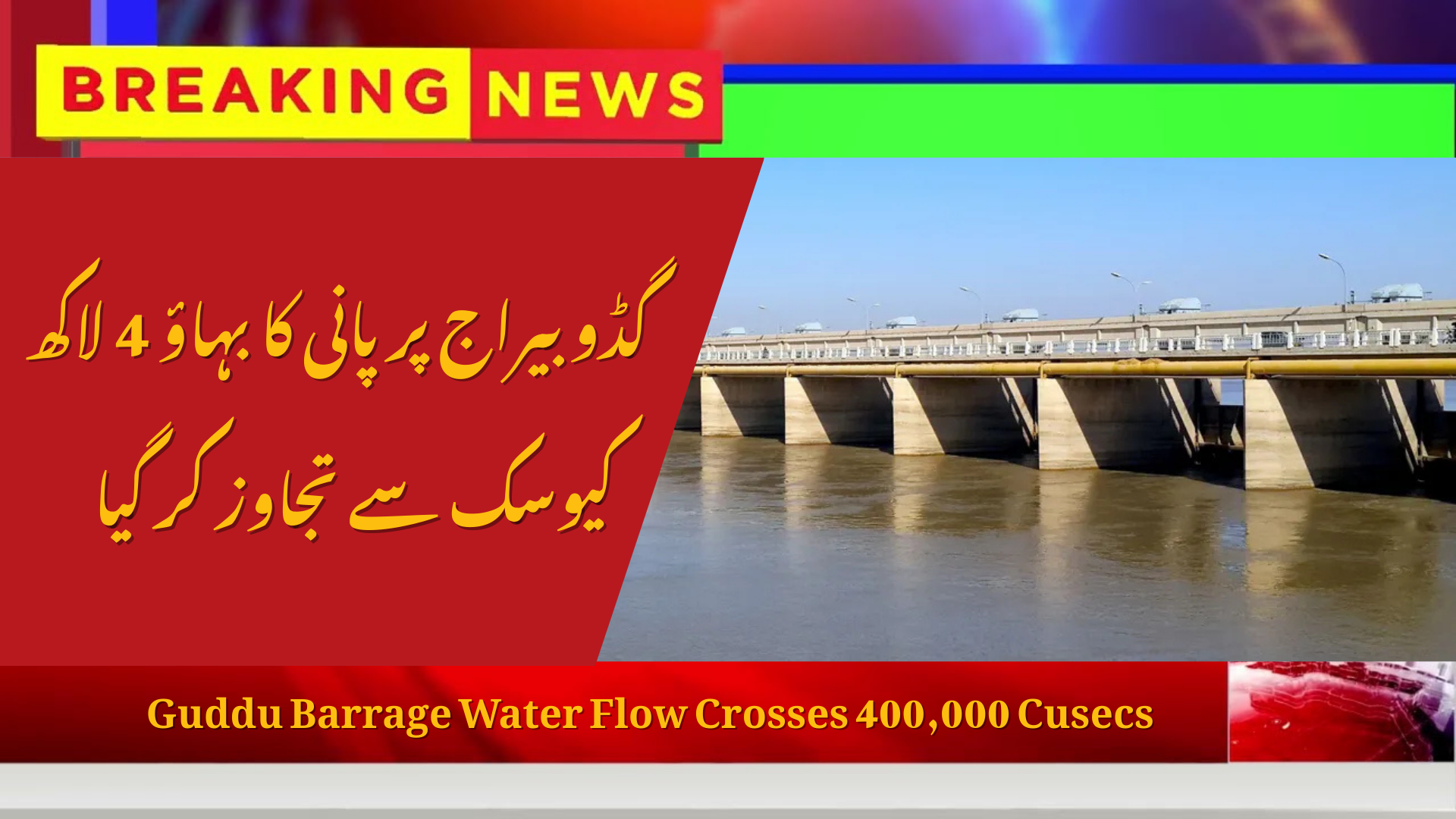The Guddu Barrage water flow crosses 400,000 cusecs this week, putting both Sindh and Punjab on high flood alert. As river levels continue to rise, local authorities are warning nearby communities to stay prepared. The situation is alarming as the Indus River and its tributaries face heavy inflows, increasing the risk of large-scale flooding.
This article explains the latest updates from Guddu Barrage, the impact on nearby areas, the situation in Punjab and Sindh, and how the government is responding to this growing emergency.
Flood Situation Worsens in Sindh
The Guddu Barrage, built on the Indus River, is now under extreme pressure. Officials confirmed that the barrage has recorded water inflows exceeding 400,000 cusecs, which is a high-flood level.
Key Concerns
- Risk to nearby districts: Sukkur, Kashmore, and surrounding areas are most at risk of flooding.
- Preparedness measures: Authorities are reinforcing embankments and monitoring sensitive points.
- Emergency response: Disaster management teams are on high alert to provide quick support.
The rising inflow is raising fears that further rains or upstream water releases could create an uncontrollable flood situation.
Sutlej River Flood in Bahawalpur
While Sindh struggles with rising Indus water, Punjab’s Sutlej River is also experiencing a dangerous surge.
- Water flow in Bahawalpur’s Sutlej River has reached 319,000 cusecs.
- Settlements near the Northern Bypass are already facing water entry.
- At Head Sulemanki, authorities have declared a high flood level, while Head Islam faces a medium flood level.
Rescue teams are actively evacuating people from villages and towns along the floodplains. The focus remains on shifting residents to higher ground before the situation worsens.
Rajanpur’s Kachha Areas Under Threat
In Rajanpur, the low-lying Kachha areas along the Indus River are particularly vulnerable.
- Rising water levels are flooding agricultural lands and mud settlements.
- Villagers are being relocated to temporary relief camps.
- The government is providing food, clean water, and medical supplies.
However, due to limited resources and the scale of the flood, many families are still waiting for full support. Relief operations are ongoing but face logistical challenges.
Government Response in Sindh
The Chief Minister of Sindh has called the situation a critical flood emergency. In a cabinet meeting, he directed all departments to remain on high alert.
Government Measures
- Relief camps: Established across Sukkur, Kashmore, and Ghotki districts.
- Health facilities: Mobile medical units are treating flood-affected families.
- Coordination: District administrations are working with disaster management authorities for smooth relief supply.
The Sindh government has also appealed for federal support in case water levels continue to rise at Guddu Barrage.
Why Guddu Barrage Matters?
The Guddu Barrage, constructed in 1962, plays a key role in managing Indus River water. It controls irrigation supply to millions of acres in Sindh and Baluchistan. However, when water inflows cross 400,000 cusecs, the barrage faces serious flood pressure, threatening both agriculture and residential settlements.
Impact on Communities and Agriculture
Floods are not only displacing people but also destroying crops and livestock.
- Agricultural loss: Standing crops of cotton, sugarcane, and rice are at risk.
- Livestock displacement: Villagers are struggling to save their animals.
- Economic damage: Farmers may face huge losses if flood levels do not recede soon.
The long-term economic burden could affect thousands of families dependent on agriculture.
How Authorities Are Managing the Situation
Authorities at Guddu Barrage and other flood points are taking multiple steps to reduce damage:
- Continuous monitoring of water levels.
- Strengthening bunds (embankments) to prevent breaches.
- Evacuation plans for villages in sensitive zones.
- Deployment of boats for rescue operations.
- Stockpiling of relief goods including tents, food, and medicines.
Safety Advice for Residents
If you live near Guddu Barrage, Rajanpur, or Sutlej River flood zones, here are some safety tips:
- Stay updated with official flood warnings.
- Move to higher ground immediately if water enters your area.
- Keep emergency kits ready with medicines, food, and clean water.
- Avoid crossing flooded areas to reduce risk of accidents.
- Cooperate with rescue teams for safe evacuation.
Latest Flood Levels at Key Points
| Location | Water Flow (Cusecs) | Flood Level | Status |
|---|---|---|---|
| Guddu Barrage | 400,000+ | High Flood | Emergency monitoring |
| Sutlej River | 319,000 | High Flood (Bahawalpur) | Evacuations ongoing |
| Head Sulemanki | Rising | High Flood | Relief teams active |
| Head Islam | Rising | Medium Flood | Monitoring continues |
| Rajanpur (Kachha) | Rapidly increasing | Localized flooding | Villages being evacuated |
Conclusion
The Guddu Barrage water flow crossing 400,000 cusecs is a major warning for both Sindh and Punjab. With the Sutlej River also under high flood levels, the combined impact is creating a serious emergency for thousands of families.
Authorities are working to strengthen flood defenses, evacuate vulnerable communities, and provide relief. However, continuous rainfall or upstream water releases could further increase the danger.
Staying alert, following government instructions, and moving to safe areas are the most important steps for people living near flood-hit regions.













